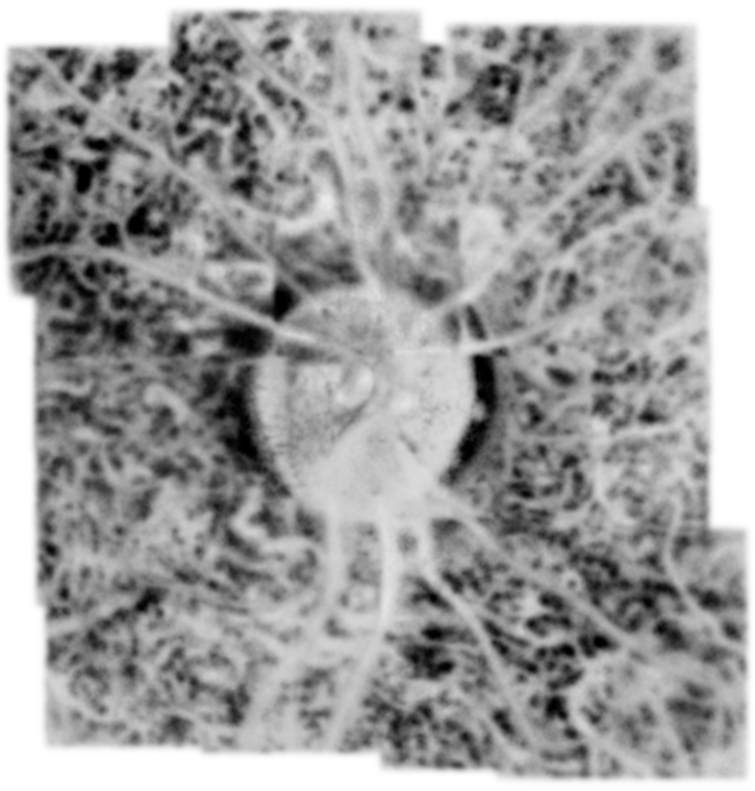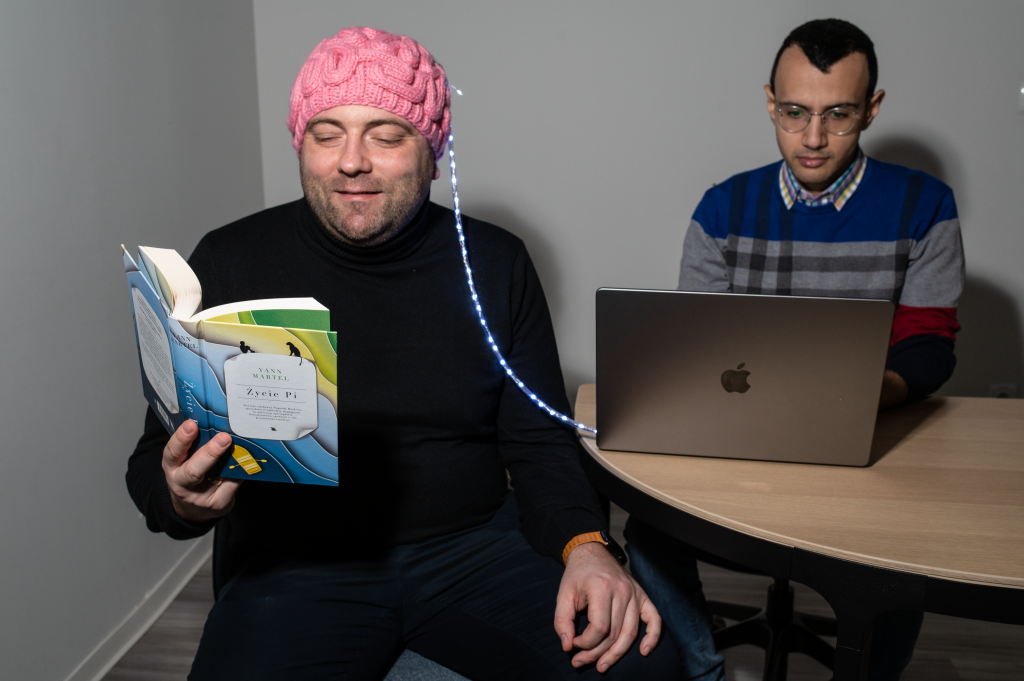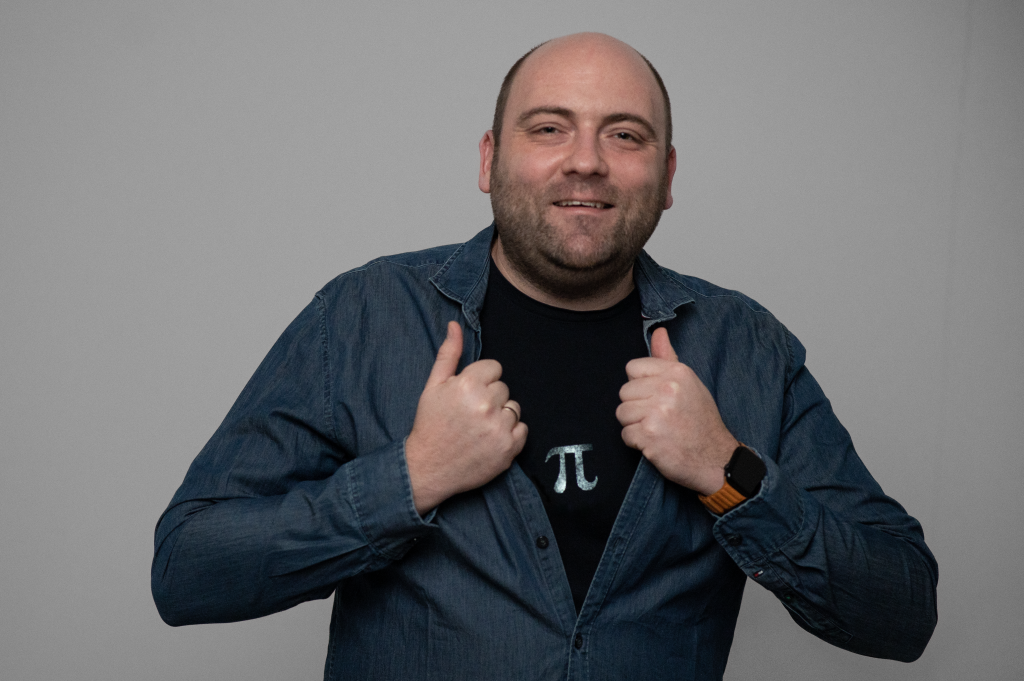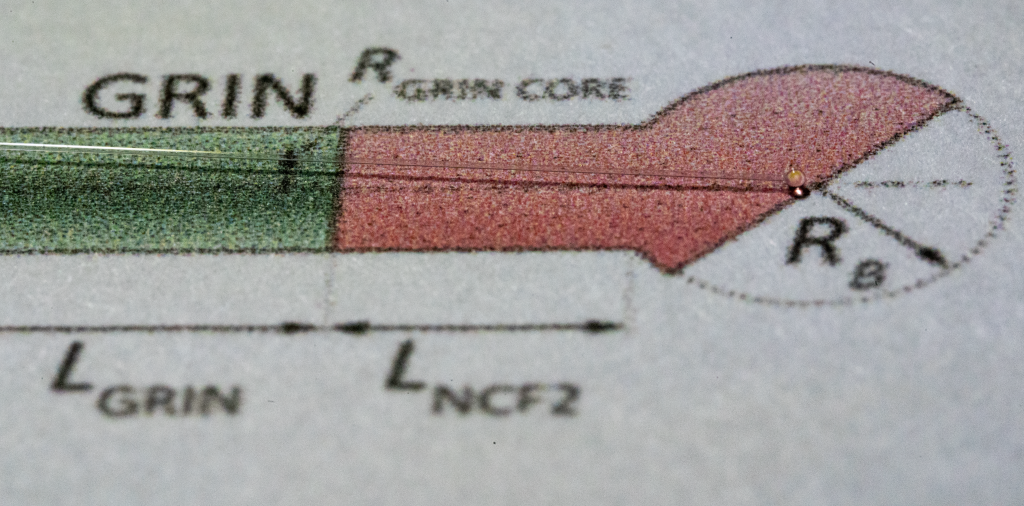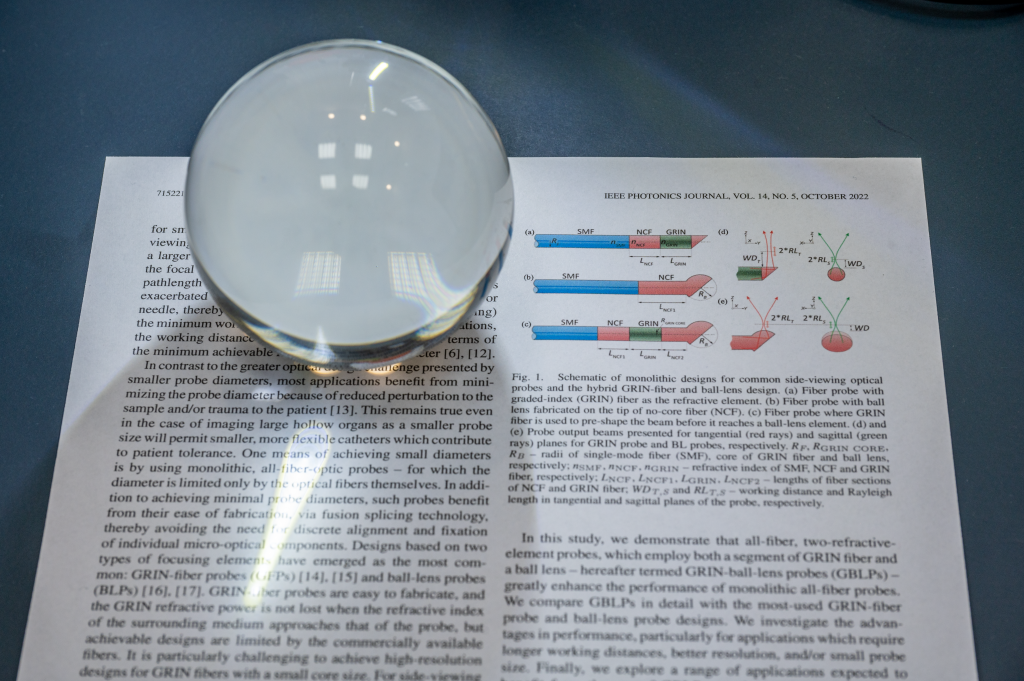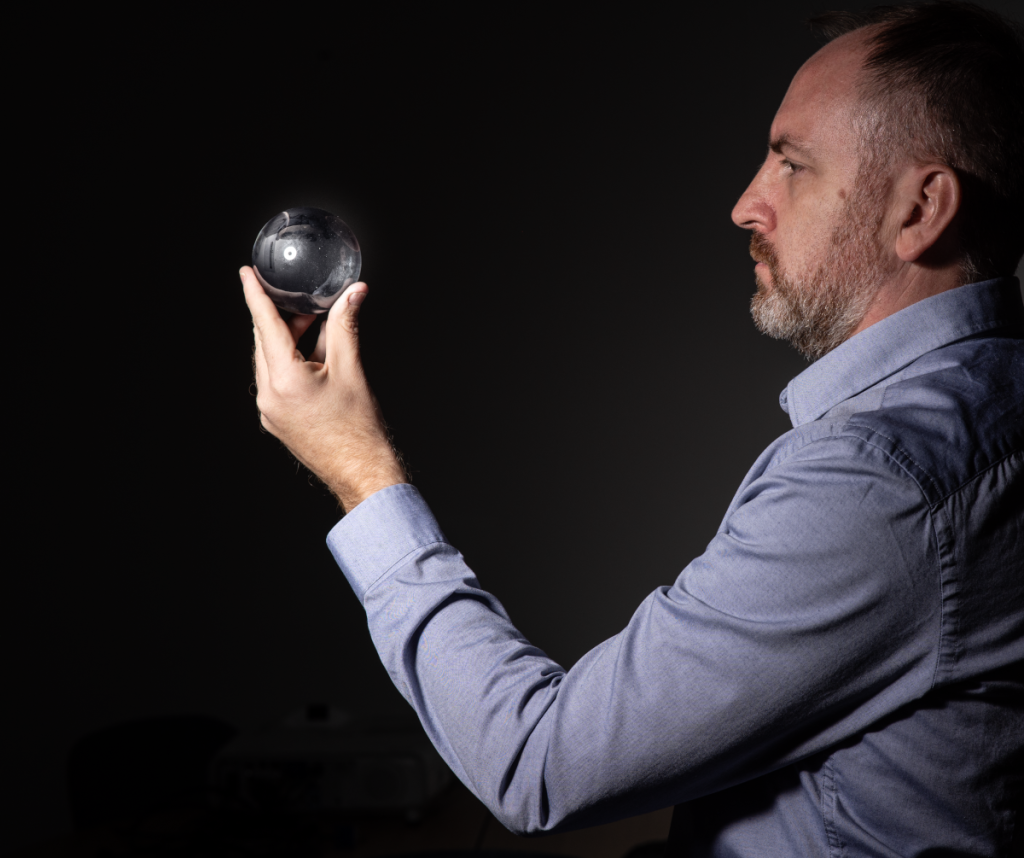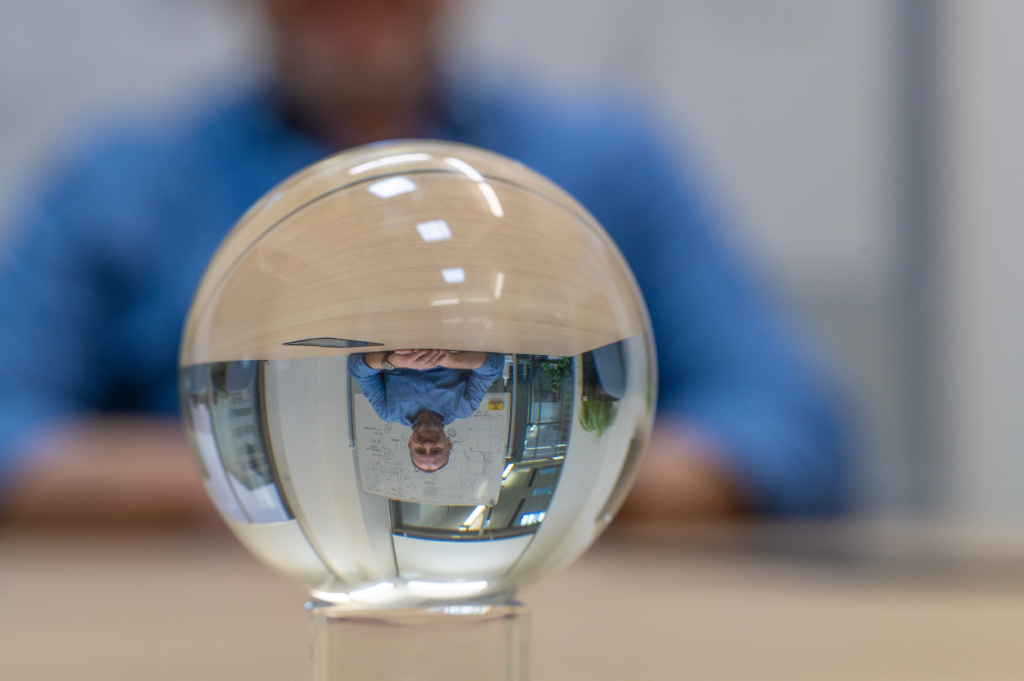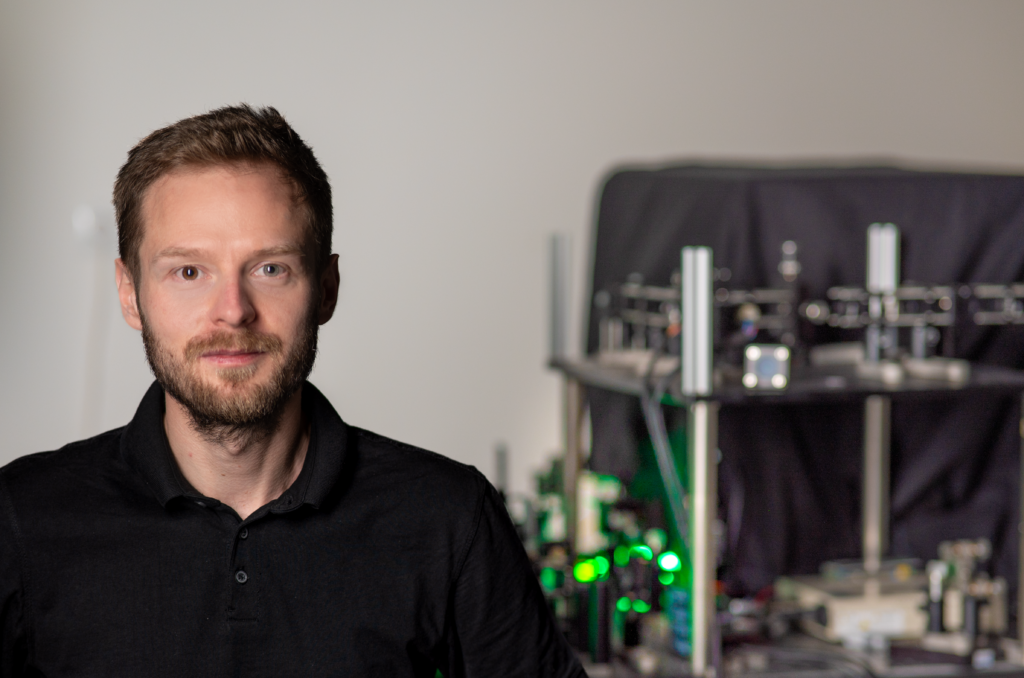Dr. Anna Ambroziak is an ophthalmologist specializing in eye diseases with 27 years of professional experience and an Assistant professor at the Faculty of Physics, University of Warsaw. Dr. Ambroziak is a member of the Polish Society of Ophthalmology (PTO) and the Society of Polish Ophthalmic Surgeons (SCOP). Dr. Ambroziak is also the Polish representative in the European Contact Society of Ophthalmologists (ECLSO), lecturer at the European Studies in Ophthalmic Optics and Optometry, and editor of the position paper of the Polish Expert Group of the Academy of Ocular Surfaces.
Dr. Ambroziak has more than 200 publications to her credit. She promotes the idea of interdisciplinary cooperation. She adheres to the philosophy of a holistic approach to the patient. Under her leadership, the Ophthalmic World Eye Center in Warsaw (Centrum Okulistyczne Świat Oka) has won the Health Ambassador Award for its expertise, experience and improvement in patients’ quality of life.
Based on the clinical studies conducted by Dr. Ambroziak, a therapeutic lens made of lotrafilcon A was registered by the US FDA. She is the winner of the ECLSO “Kersley Lecture” grand prize and the Medical University of Warsaw Scientific Award.

We present an interview with Dr. Anna Maria Ambroziak conducted by the Physical Optics and Biophotonics group at ICTER.
In recent years, the development of cooperation between ophthalmology and optometry in Poland has been noted. ICTER brings together specialists from the fields of optics, optometry, engineering, physics, biochemistry, mathematics to create specific tools and solutions that can translate into improved patient care. How do you think the collaboration of those involved in vision science has been changing in Poland over the past decades?
So, to begin with, a little bit of my personal memories, which will shed some light on the history of optometry in Poland. That is, a few words about how Optometry became the foundation of Ophthalmology in the country on the Vistula River.
In ’98, as a member of the Board of Directors of the Contact Lens Section of the Polish Ophthalmological Society, I organize a meeting, and a few months later a contactology symposium. That’s a little over a year after the first year of optometry postgraduates graduate from the K. Marcinkowski Medical University. The following years saw more conferences. Among the guests invited to the symposium were world-renowned optometrists, contactology experts – including Brian Holden, Lyndon Jones, Philip Morgan, Keith Edwards, Dwight Akerman, Brian Tompkins, Eric Papas and myself – a young ophthalmologist ready to change the world. Since the beginning of my career, I have been involved in the education and development of optometrists. I have been working at the University of Warsaw since 2011, for more than 10 years served as deputy editor-in-chief of the medical journal Contactology and Ophthalmic Optics. I took an active part in such events as the introduction of the world’s first silicone hydrogel lens to the Polish market. My love for contactology exploded suddenly and turned into a mature, fulfilling relationship. Scientific research on the effects of prolonged contact lens wear on the ocular surface became the subject of my doctoral dissertation defended with distinction at WUM. On the basis of clinical studies conducted by me, a therapeutic lens made of lotrafilcon A was registered by the US FDA. To paraphrase a classic, it was worth looking at such a map of the world which includes utopia. For me, there was no dilemma, problem or division. The more I know, the more questions I ask and the more joyfully I share knowledge. In this natural environment of broadly understood vision care, we should work together to best serve each other and our patients. There is no room for divisions here, we are one compatible, integral creation and naturally work together. For a wise scientist, the other person is an opportunity for development and cooperation, and if also for competition – it is only for the positive and constructive one. Years of work and creation of this ideal world have allowed us to raise new generations of specialists, these new generations work with each other and learn from each other. The Ophthalmic Center Świat Oka is a scientific and research & science clinic with modern training facilities, where optometry and medical students learn and work under the supervision of specialists, where clinical trials of drugs and technologies are carried out, and papers and publications are produced, including many on rules of procedure and ophthalmic-optometric cooperation. I strongly recommend this model. There is much work ahead of us, but let’s remember that changing the world should always start with ourselves. I have been supporting the development of Optometry in Poland since the beginning, working as an assistant professor at the Faculty of Physics at the University of Warsaw. In the academic environment of Warsaw, I was the first ophthalmologist to start teaching new generations of optometrists – teaching the younger generations at a proper level should be the primary goal for eye care specialists. I execute the plan according to which the Ophthalmologist and the Certified Optometrist work together on one level. This cooperation is not possible without the presence of scientists from the fields of optics, physics or mathematics, biology and chemistry. Education and Science is the future not only for this country, but for the whole world.
What are the most troublesome diagnostic limitations and needs of a modern ophthalmology center? If you could “conjure up” the equipment of your dreams, what would it diagnose (or what other function would it perform) and how?
Our tears are a vast, still tentatively explored, wealth of knowledge about our organisms enabling us the insight into more than just our genomics, and this is one of the directions I dream of.
Our brains are the realm where perception happens and where reality is created, and we can extend it using artificial intelligence; this is another important signpost for female and male wizard scientists.
The power of now shows, at the same time, a great need to monitor the progression and development of myopia. We know more and more about the effectiveness of the available solutions and are oriented towards polytherapies. We know more and more about new optical designs for eyeglasses and contact lenses, and about the long-standing results of meta-analyses of the use and clinical evaluation of these products. We are definitely vocal about the need to measure the axial length of the eyeball, the need to monitor and treat pre-myopia, and the impact of the pupil width on monitoring the development and progression of myopia. The power of now is also the power of creation, so we keep track of what science brings to practice. For example: Transplantation of embryonic human stem cells into the retinal pigment epithelium (RPE) is happening before our eyes – now in the cases of age-related macular degeneration, but soon in myopic maculopathy. The M1 molecule promotes the regeneration of retinal ganglion cell axons which means the potential to restore the activity of target neurons and thus restore visual function in cases of both maculopathy and neuropathy.
Do you think the demand for devices and techniques for visual system diagnostics will grow in the near future? Why?
The eyesight is the most important sense, but it is subject to a series of involutionary processes and the influence of exo- and endogenous factors. The increase in life expectancy has made the estimation numbers in epidemiology unequivocally indicate the imminent scale of the challenge. Returning to the example of myopia, we know that soon half of the world’s general population will be myopic and thus the number of myopia-related complications will increase, including the most serious and severe myopia-related maculopathy, which does not exclude the coincidence of age-related changes. Prevention based on modern, reproducible, minimally invasive and highly specific diagnostics is the basis of ophthalmology. In addition to the pandemic of myopia, often the same patients due to being overweight and obese add to a growing group of patients burdened with diabetes. In this group, the rise of maculopathy is also a critical challenge.
Online doctor consultations are already exploiting algorithm and data analyses today. Diagnostic tests and therapeutic regimens are becoming more precise, new previously unknown solutions and materials are being used. Technologies using virtual reality are already the foundation of our practice in vision therapy.
Artificial intelligence in the daily work of an eye care specialist involves much more than just monitoring fundus changes or the screening programs we are already familiar with nowadays and that are particularly advanced in the prevention of diabetic changes. The pandemic has brought us new challenges, new goals and new experiences.
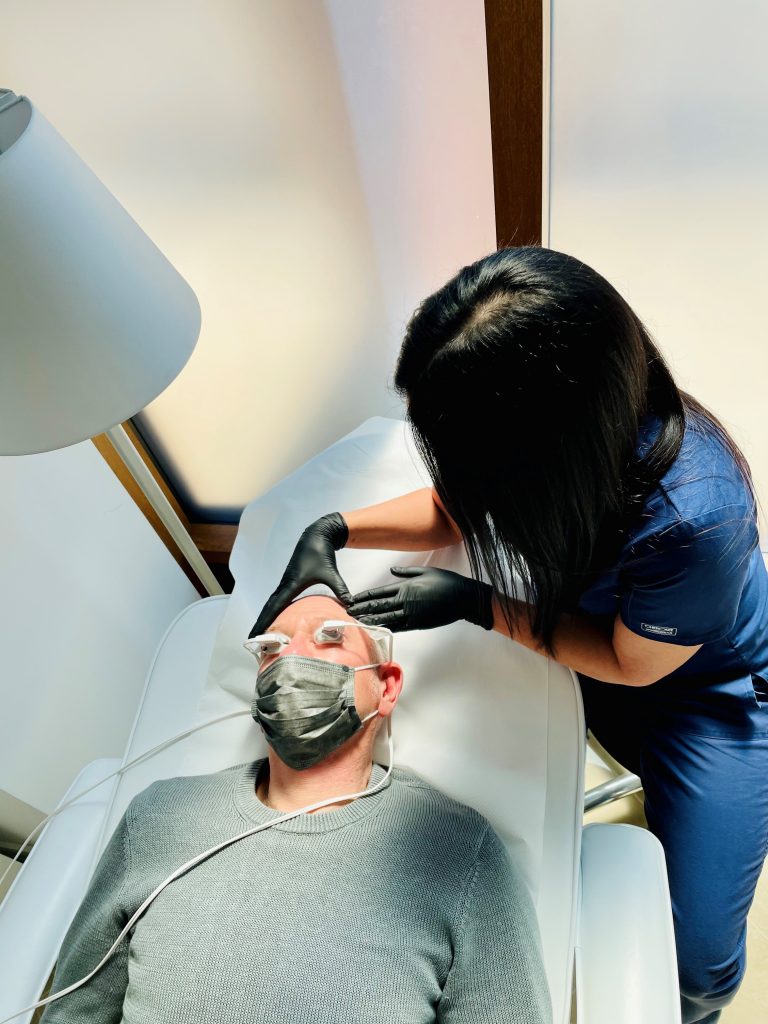
Are there eye diseases whose pathogenesis we have yet to understand? Do they occur frequently – affect many people?
As I mentioned, the time of SARS-COV-2 is an acceleration of the development of the implementation of technological innovation and artificial intelligence in medicine. For us, this time is also the intersection of the myopia pandemic, diabetic eye syndrome and digital visual fatigue, with numerous challenges ahead.
The foundation of Science and Humanity is to develop and provide open-ended answers.
The pathogenesis of most ophthalmic conditions is based on genetic and environmental risk factors yet a shift in the importance of genotype versus phenotypic expression under the influence of external and internal causes of an individual definitely took place.
If we use the example of intelligence, as my “genetic masters” Prof. Ewa Bartnik and Prof. Wojciech Dragan say, when we analyze the entire population (from a newborn to the oldest person) the level of heritability of intelligence is 50%, and differences in the influence of genes on intelligence depend on the activity of the environment.
Genetic variances and environmental variances are constantly modifying our pathogenetic cocktails. If we analyze the non-modifiable and modifiable substrates, the last decades and years, in addition to the positive aspects such as extending our lifespan , and remember that age is the primary risk factor for diseases of all kinds, risk factors such as climate change, environmental pollution, changing educational and working conditions, food modifications, widespread consumption of excess calories, especially in the form of highly processed, sweetened products are now critical health challenges, also for the organ of the visual system.
Psychology and especially psychosomatics are also of increasing importance.
Visual perception is another area being explored and tamed.
In a world of artificial intelligence, we still lack an integral view, and currently, all technologies absolutely require reason and humility, and human knowledge. Soon, refractive lens and corneal surgery will move toward modifying the cornea and implanting specific lenses that will adapt their optical properties to our visual requirements, varying lighting, different contrast and dynamic visual work distances. We are very privileged that such a huge technological leap has taken place before our eyes. Education, thanks to new tools and especially the use of the metaverse world, will also be decidedly friendlier.
We have shifted the boundaries of senior age and the age of 40-65 is called maturity and we increasingly speak of old age only after the age of 80.
We mature, develop, age, we are subject to involutionary changes and multiple factors from the day we are born and even throughout our fetal life. This applies to all structures of the eye, but especially significantly to the retina and lens, which processes known as presbyopia are associated with. Keep in mind that it is not a disease, but many conditions can accelerate and intensify this process.
The lens of the human eye is an intraocular structure whose main tasks are active participation in accommodation, refracting light and maintaining clarity. A normal lens, outside of fetal life, is devoid of blood vessels and nerves and is completely transparent. The lens of the eye is a unique structure, and its growth is caused by the addition of new cells inside the surrounding capsule. The new fibers become thickened and fuse with those previously formed. Older cells are not discarded or removed, but placed in its center. This is necessary to maintain the metabolic viability of the outer cortex (and thus the entire organ) and to produce the refractive properties necessary to focus images on the retina and reduce spherical aberration. With age, however, this brings undesirable consequences, including the development and progression of presbyopia.
Presbyopia is not a refractive defect, it is a peculiar indisposition of near vision manifested >40 years of age resulting from widespread involutionary processes. It is caused by physiological anatomical and functional changes occurring in the intraocular lens, especially its capsule, and functional changes in the ligamentous apparatus, resulting in decreasing amplitude of accommodation, i.e. reduced/insufficient ability to sharpen the image of close objects. Interestingly, the strength and work of the ciliary muscle is not affected, thus the full contraction and diastole of this muscle induces adequate changes in the tension of the ligamentous system, and only these forces are met with an altered susceptibility of the lens capsule and the lens itself to respond to a given accommodative stimulus. Such a condition calls for support, i.e. optical correction for nearsightedness. Its recommendation should not be delayed, as procrastination may result in causing symptoms of asthenopia and impaired nearsightedness in the future.
Let’s give our organ of the visual system the best possible correction, let’s use all possible solutions. Our brains like to be given tasks, they like to learn, and if we feed them properly, they will help us use more and more precise, higher resolution correction methods for years to come, as long as we make sure that the plasticity of our brain is preserved.
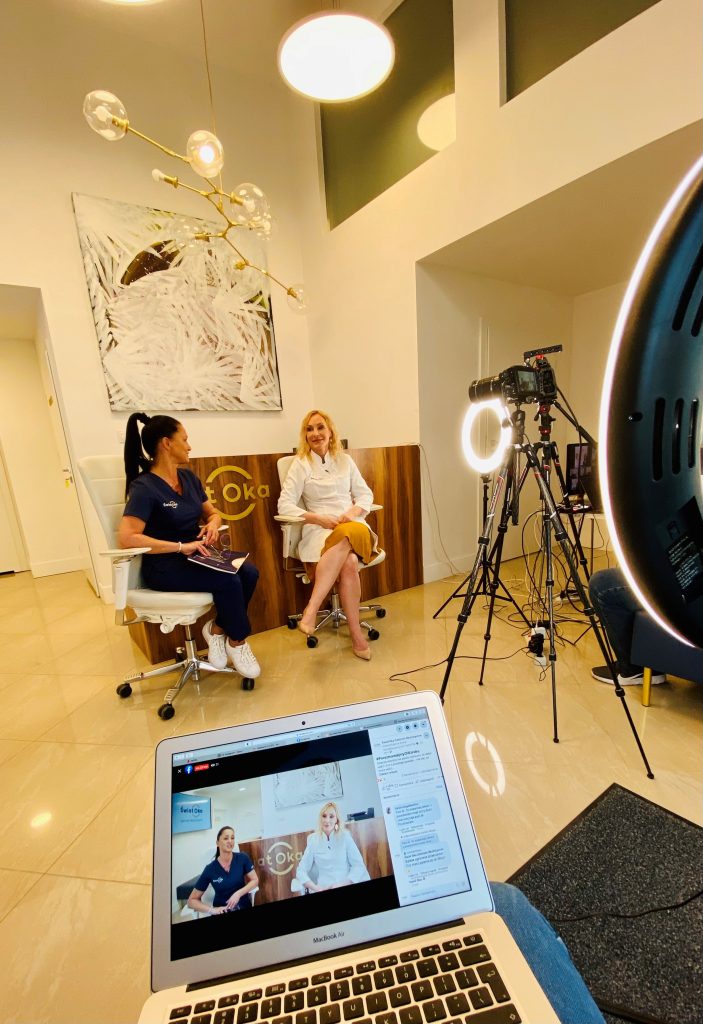
Can we guard against age-related retinal degeneration? What can we do in this area and, in your opinion, is such knowledge generally available?
The basis of ophthalmology is prevention and age-related maculopathy is a classic example of this. If we have a positive family history and other risk factors besides age, such as nicotinism, atherosclerosis, carbohydrate-lipid disorders, among others, then we should not delay screening and perform it systematically. Age-related macular degeneration (AMD) is the most common cause of so-called “practical blindness” in developed countries, occurring most often in people over 50. It is believed that the incidence of AMD will increase as a result of global population aging. AMD is a degenerative disease that destroys the retina in the place that is the most critical to the vision process – the macula, most often through atrophy of the pigment epithelium, choriocapillaries and photoreceptors and the development of pathological neovascularization. The pathogenetic mechanisms of the disease, described in detail, are indirectly responsible for its early and correct diagnosis. Knowledge of the processes that occur in aging tissues, as well as complex processes caused by external factors and genetic conditions, allow specialists to differentiate the degenerative changes that arise and classify them into different stages of disease development. A number of risk factors, which are divided into modifiable and non-modifiable ones, are subject to analysis both to assess the risk of the onset of the condition and its subsequent progression. Ongoing research on these factors is focusing the attention of specialists on their potential use in prevention and therapy. An interview based on these risk factors provides important information about the patient’s overall health and predisposition to develop maculopathy. In the diagnosis of AMD, there is no single rigid regimen of management, since the disease is not homogeneous and is characterized by a very wide spectrum of symptoms. Among the diagnostic methods described, imaging studies predominate, which can be divided into invasive studies – advanced vascular studies performed by ophthalmologists, and non-invasive studies – imaging degenerative changes, performed by both teams of specialists. Early diagnosis of age-related macular degeneration offers the possibility of preserving the patient’s normal visual function. The progression of untreated disease promotes the development of symptoms whose effects are irreversible.
AMD is an example of a disease in which a holistic view of the entire body is critical. The patient should therefore take full responsibility for his or her health and ensure proper diet and physical activity and not delay a visit to a specialist. Education level is insufficient in every dimension of our physical, mental and social well-being.
One of the world’s most popular imaging diagnostic techniques is optical tomography OCT. Recent research conducted at the International Centre for Translational Eye Research (ICTER) under the supervision of Professor Maciej Wojtkowski have allowed the development of an improved method called Spatio-Temporal Optical Coherence Tomography (STOC-T) that enables imaging of the retina with preserved high-resolution at any depth in the frontal section. The use of STOC-T for retinal imaging makes it possible to reconstruct the morphology of the cones in the human eye. From your point of view, why is retinal imaging important? Which diseases would imaging of the morphology of the cones be crucial for?
OCT is a widely used technology in ophthalmology and allows imaging of all structures of the eyeball, both anterior and posterior, but the greatest research and scientific achievement is in imaging the retina in the central, or macular, area.
Imaging of the morphology of the cones opens a kind of gateway to eternity by enabling anatomical and functional monitoring of photoreceptors that receive visual stimuli and thus informs the first changes leading to, and long before, the onset of maculopathy. It thus provides us with a range of variables for monitoring and modifying perceptual processes, including particularly promising prospects for detecting dementia-like changes and thus accurately assessing cognitive and executive functions.
The key to the future is to capture the state in which the physiological changes that occur in the aging process of eye tissues transform into pathologies.
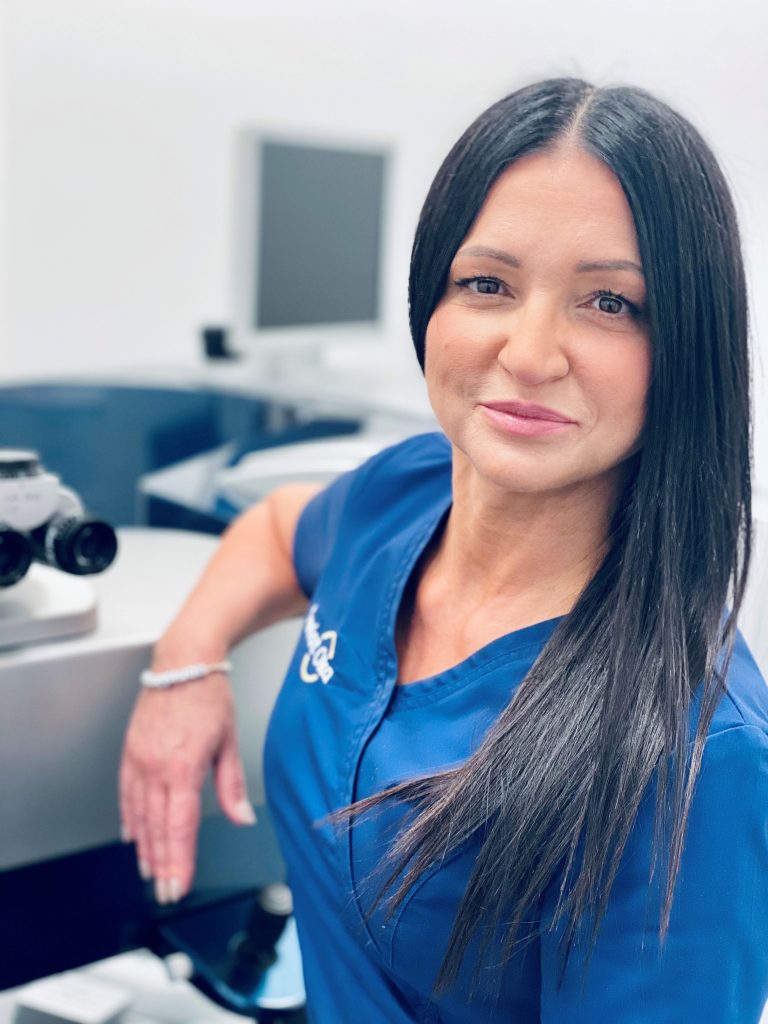
For the diagnosis of retinal diseases, not only structural, but also functional changes are important. The group of functional methods includes a precise variant of visual field testing – microperimetry. A novel method is being developed at ICTER: two-photon microperimetry, which takes advantage of the two-photon vision effect occurring when the retina is illuminated by a femtosecond infrared laser pulse. Physics shows that the longer the wavelength of light, the weaker it scatters in the medium. Therefore, in your opinion, can the use of infrared for functional vision testing expand the applicability of microperimetry?
Absolutely yes.
Both in terms of screening in at-risk groups and the broad prevention of macular disease, as well as the standards of management of myopia and glycemic/diabetic disorders.
Comprehensive diagnostic measures performed by ophthalmologists and optometrists are the cornerstone of their daily practice. Complementary examinations performed by both teams are the basis for proper and early diagnosis of many diseases of the visual system and implementation of effective treatment. In the diagnosis of retinal diseases, the range of examinations is very wide and includes both invasive methods and increasingly popular non-invasive examinations, which are expanding the standards of ophthalmic-optometric examinations.
Our research shows that two-photon microperimetry has better repeatability than traditional microperimetry. In your opinion, could this be important for diagnosing eye diseases or tracking their progress? If so, for which diseases in particular?
Absolutely yes.
Precise assessment of the progression of changes over time and high sensitivity and specificity of central perimetry parameters are the greatest challenges of current diagnostics.
Each of the broad spectrum of entities in the maculopathy family requires reproducible data, but myopic maculopathy should definitely be highlighted in this group.
Let’s return to imaging methods by staying with two-photon effects: we are also developing a two-photon variant of fluorescence scanning laser ophthalmoscopy. A standard fluorescence scanning ophthalmoscope (SLO) uses a beam from the visible range, with a wavelength of typically around 480 nm (blue). This wavelength allows to excite the fluorescence of lipofuscin deposits in the pigment epithelium, but not of pigments involved in visual cycle transformations, such as retinyl esters. They are excited with shorter wavelengths, absorbed in the cornea, so it is impossible to detect them with such a standard SLO. The two-photon variant of this device that we are developing at ICTER circumvents this limitation. Do you think this could be an interesting tool for ophthalmologists?
Absolutely yes for the third time. The two-photon effect, as in perimetry, totally changes the perspective and raises the level of reliability of the examinations carried out, which is particularly justified in combination with SLO technology, since it makes it possible to detect changes at the cellular level in the period before the formation of functional changes, such as perimetric changes.
What are the available methods of keratoconus examination? What are their limitations?
First: genetics has entered diagnostics.
Second: imaging is giving us a new generation of tools with increasingly higher resolution and precision.
Corneal cone (Keratoconus, KC) is a bilateral, albeit asymmetric, condition that involves progressive thinning and convexity of the cornea, leading to irregular astigmatism. Keratoconus usually develops in the second or third decade of life. The condition affects all ethnic groups and both sexes. The prevalence and incidence rates of keratoconus can vary by geographic location and age of onset.
Approximately 73% (16 of 22) of human autosomal chromosomes are associated with KC , and 59% of these can be considered to show statistically significant associations (8 of 63). Studies suggest that it may be a polygenic disease, meaning that two or more affected genes are required for the development of keratoconus.
Keratoconus is a multifactorial disease and many genetic factors, along with various external factors, influence phenotypic expression and its development.
And what do we know from the Polish research I have been doing for many years? That is, what do we know about the KC-related protein?
The ALDH3A1 protein is important in maintaining corneal physiology and protecting the eye from UV damage. However, no genome-wide association study has shown that the ALDH3A1 locus is associated with keratoconus. In this study, we investigated the potential role of ALDH3A1 variants as risk factors for the onset and severity of KC in a large group of Polish patients with keratoconus. In the first step, we analyzed the sequence of the coding region of ALDH3A1 in the KC subgroup. We then genotyped three selected ALDH3A1 variants in a larger group of KC patients (n=261) and healthy controls (n=317). We found that the minor A allele of rs1042183 is a risk factor for keratoconus in the dominant model. Genotypes of the rs2228100 variant appear to be associated with an earlier age of KC diagnosis in the Polish population (p=0.055 for the comparison of the three genotypes and p=0.022 for the dominant inheritance model). We showed that the rs1042183 variant in the ALDH3A1 gene is associated with predisposition to keratoconus in the Polish population. The allele frequency of ALDH3A1 variants associated with KC varies in different populations, which may be partly responsible for the difference in KC prevalence worldwide.
Early studies that diagnosed keratoconus were based mainly on symptoms seen on retinoscopy, non-standardized keratometry measurements and subjective assessment of clinical symptoms. Another diagnostic parameter is pachymetry, or corneal thickness assessment. We use different technologies and base the measurements on specific maps.
Until the development of technology and the advent of the ability to diagnose keratoconus with topography and high-resolution optical coherence tomography, information about corneal curvature was provided by keratometry.
Both pachymetry and keratometry are an essential part of the examination performed by an ophthalmologist or optometrist. The measurements obtained during the examination with an autorefractometer, should be the starting point of a comprehensive diagnosis.
Optical coherence tomography is a non-contact and non-invasive method of receiving and then processing an optical signal. It uses superluminescent diodes, which are a source of low-energy infrared light, to image high-resolution structures of the anterior segment of the eye. It is a Swept Source (SS-OCT) device that uses a long-wavelength light source with a central wavelength of 1310 nm and has a speed of 30,000 axial scans per second. The use of long-wavelength light, reduces unwanted scatter, and this results in a greater ability of the light to penetrate opaque structures, i.e. through the sclera or opaque cornea.
The device, performing qualitative analysis of the collected data, forms various types of tomographic and topographic maps of the anterior surface of the eye, the device generates a report respecting the percentage of similarity of the examined patient’s cornea to a typical cone eye model (ESI – Ectasia Screening Interpreted). Anterior corneal curvature and anterior and posterior astigmatism are significantly elevated in a person diagnosed with keratoconus; these parameters are not particularly useful in differentiating subclinical keratoconus from healthy eyes.
Epithelial criteria are the current diagnostic trend.
In daily practice, the usefulness of posterior corneal measurements continues to be emphasized, as changes in the posterior surface of the cornea can be one of the first clinically detectable signs of keratoconus. These measurements could not previously be obtained from traditional reflection-based topographers; they are measured using Scheimpflug imaging and anterior segment optical coherence tomography (AS OCT). By comparing topography maps taken over months and years, a trend curve of the condition is generated, e.g., the Cone Trend Analysis report, which is a key element in assessing the progression of keratoconus repression. A limitation, and thus a diagnostic challenge, is the detection of preclinical cases (pre-KC).
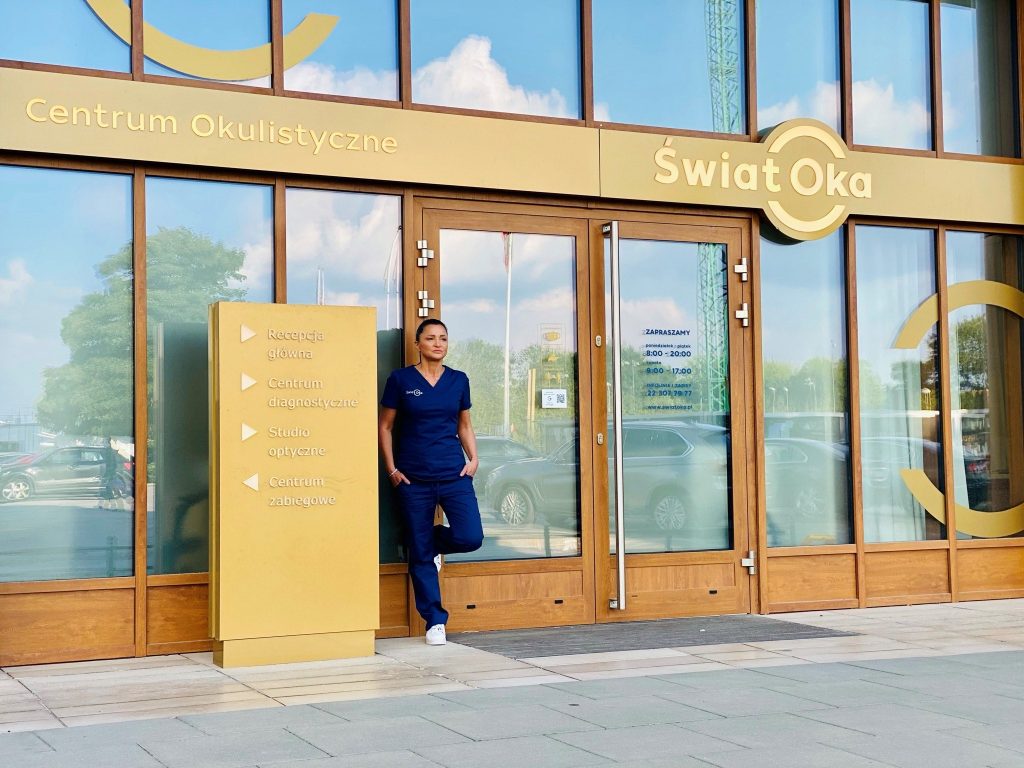
What fields will develop in the next 10 years? What are the biggest challenges for scientists in the field of optics, optometry, ophthalmology and for medical staff specializing in the diagnosis and treatment of eye disorders?
New optics and the use of artificial and augmented intelligence are among the trends, simultaneously, we know more and more about our brain and are pushing the limits of neuroregenerative abilities. Still, the most common cause of decreased visual acuity is uncorrected inaccuracy. The visual organ allows us to perceive stimuli from the surrounding world. Visual sensory fibers have the largest brain representation among our senses, the information transmitted through them, however, requires a very precise receptor. More than half of European adults are diagnosed with refractive errors (myopia≤-0.50, hyperopia ≥+0.75, astigmatism ≥0.75). Everyone over the age of 40, regardless of the type and level of non-massive refraction, needs nearsightedness-support, i.e. correction of presbyopia. Still, despite such modern tools, very often the visual defect is not corrected or is only partially corrected. According to estimates, at least one in two adults should use glasses or contact lenses or another form of correction, but this is not the case. This fact has strong economic implications, both individually and socially, and is a potential cause of decreased productivity and quality of life. I am pointing to significant differences in the assessment of most functions, from overall quality of vision to mental health.
Most of us believe that the primary symptom of an uncorrected vision defect is blurred vision. We see with our brains. The brain selects sharp images, and the eye, thanks to its ability to accommodate, can sharpen the image provided by the impulse. This explains in some cases the ability to read despite the lack of proper correction.
A patient with an uncorrected visual impairment subconsciously seizes the opportunity to minimize the discomfort of a blurry retinal image and squints. Narrowing the eyelid crevice restricts the access of rays that run off-axis through the optical system of the eye. Light rays that enter the receptors in the retina when the eyelids are closed run axially and have a much smaller effect on blurring the image than off-axis rays. By squinting, a person with a refractive defect makes the image they see clearer, but is still subject to the typical symptoms of asthenopia, which is a reaction of the visual system to increased visual effort caused by an uncorrected refractive defect, most often hyperopia and astigmatism. Other causes of asthenopia can be phoria, which is a misalignment disorder of binocular vision, convergence or accommodative disorders.
There are a number of mechanisms in the human visual system that offset the discomfort caused by visual defects or disorders of the visual system, including fusiform vergence or accommodations. These mechanisms can become impaired during illness, under stress or as a result of intensive visual work at close distances.
The discomforts associated with uncorrected or undercorrected visual impairment are usually not sudden in nature and do not cause ocular signs for a long time. Their occurrence is often read in terms of somatic disorders manifested, for example, by general fatigue, irritability, dizziness or headaches. We should discuss this with our patients. Adequate optimization of retinal and cerebral images expands the doors of perception and thus future possibilities for intraocular correction and neuroadaptation to modern optics.
Let us take care of the psyche and help the brain refine the senses.
My dream is education, education addressed to us – specialists, education of our patients, education of their families, education of officials and decision-makers. My dream is for patients to benefit and be aware of the need for prevention. I know this sounds like utopia to realists, but this is my reality, and I want to share it. We are the ones who create reality! If only we start with small steps, with small things, with examples, with ourselves and our own backyard and realize this ideal world. Just as in Świat Oka we showed the space for eye care professionals to work together. This is the only way we can change our reality. First of all, the environment! Our polluted world is the starting point for autoimmune diseases, and diseases on the spectrum are not only ophthalmic and ocular surface. Our contaminated air, water and soil and the lack of natural light for our young people, our children and teenagers means obesity and being overweight, it means myopia. These diseases already affect half the population of young people and their numbers are increasing dramatically. Psychosomatic diseases constitute now about 70-80% of diseases, autoimmune diseases similarly. The number of people requiring vision correction and vision therapy is similar and so few, far less than half, benefit from it. The majority of parents (more than 80%) believe, and this is us who is responsible for this educational error, that children only require vision control when they start going to school. Many still do not understand that a full Optometric and Ophthalmic examination is the basis, and we are not talking about any exceptionally high standards. At least two hours in natural light and dietary changes are the basis for holistic management of our patients of all ages. Digital eye fatigue along with disorders of the ocular surface, disorders of convergence, accommodation, with visual defects. including pseudo-short-sightedness simply require attentiveness, awareness of here and now, and willingness. No exceptional solutions or finances are needed there. Our dream for the present is for us to get examined and undergo corrections when needed. We will then be able to let our tired and irritated minds rest. The next step is modern diagnosis and treatment of ophthalmic conditions.
Eye screening programs are still needed both in developing countries and here in the center of Europe, where preventive care in ophthalmology still does not happen realistically.
———————————————————————————————————————————————————–
Interview questions prepared by: Marta Mikuła-Zdańkowska, PhD and Oliwia Kaczkoś, MSc.
Expert supervision: senior researcher Katarzyna Komar, PhD.
Additional contribution: Anna Salamończyk.
THE INTERVIEW WAS REALIZED BY THE MEMBERS OF THE PHYSICAL OPTICS AND BIOPHOTONICS GROUP LED BY PROF. MACIEJ WOJTKOWSKI, HEAD OF ICTER.




